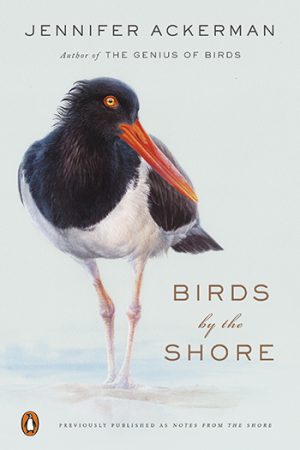From the Author

Excerpt from Birds by the Shore
I live in a small town by the sea. It sits just inside Cape Henlopen at the bottom lip of the Delaware Bay. Summer mornings, salt air sifts through the screen on my open window. Companies of gulls settle on my rooftop or sail around the church steeple across the way. On gray days, the foghorn out in the harbor bleats like a cow deprived of its calf.
One is always aware of the sea in Lewes, can feel its broad, enduring presence just over the fat humps of sand dunes. It affects people as surely as it breeds rhythms into the fiddler crab. When the wind is from the east, the saltwater leans in strong, and the sun rises pink under a moist haze. Stamps mate. Bread molds in a day. In big storms, the ocean seems to empty its belly, and even a solid house like mine feels ephemeral. The hackberry trees weep floods of tears; my drain spout gives up altogether, spewing a wide waterfall that feeds a pool at the foot of the stairs. In the small tidal marsh at the center of town, chill water rises to the tips of the cordgrass so that only specks of green show, like a lawn in a pointillist painting. When the tide shrinks, the mud- banks exhale that sharp, salty smell.
Some days, a thick sea mist creeps backward over the dunes and infiltrates the town with the ghost of deep water; then the place feels as if it were adrift, unanchored to anything.
This coast is a rhythmic landscape cut from marshes and sand and described by an early Dutchman as “beautifully level.” Age by age the ocean has risen; age by age it falls again, sweeping back and forth across the coastal plain. The ground around Lewes supports flowering plants that fare well in thin sandy soil: beach heather, bayberry, groundsel, beach pea. Because the ocean tempers the swing of seasons, it is a twin province of north and south, home to species that ordinarily do not mix. Bald cypress, muscadine grape, loblolly pine, and sweetleaf push up from their southern habitats; wild cherry, beach plum, sassafras, and laurel creep down from the north. Such northern species as eider ducks meet true southerners like the brown pelican and black vulture.
Spring and fall, flocks of migrating birds flow north and south overhead. In May, shorebirds descend from the skies to feed on our margins. Swallows mass under the August sun, stippling the dunes and beading the phone wires. When the temperature falls, the air reverberates with the calls of snow geese, which gather by the thousand in the stubbly cornfields like raucous crowds on a public beach. In winter, flotillas of scoters and scaups play the edges of the sea.
…
When I arrived, I set as my goal to look closely at the daily nature around me and by so doing, get to know the place a little. There is not a great deal on this coast that recalls the landscape of my childhood. My roots lie in the interior, in rolling deciduous woodland. Few of us have the privilege of living as adults in the place we lived in as children. Even fewer of us die where we were born. I have moved eight times in the last nine years. How many landscapes can fit inside the human heart?
At first, I felt disoriented here, as if I had been spun round blindfolded and set down reeling, wondering from which quarter the wind usually blew and whether the shroudy brown fog that appeared one morning was typical of my share of coast. I missed the hiss of wind in high trees and the sweet vegetable smell of humus and decaying leaves. I saw only the barren mud flats, the sly sameness of the marsh. I saw only surfaces.
A native landscape enters a child’s mind through a meld of sensations: the smell of seaweed or hay, the sound of cicadas, the cold grit of stone. It is all heart and magic, confusion rather than order, but the feeling it evokes is wholly satisfying and lasting. Gaining this kind of deep familiarity with a landscape other than your native one is like learning to speak a foreign language. You can’t hope for quick or easy fluency. You work from the outside in, by accumulating a vocabulary of observed details. You learn where things happen in the rhythmic revolutions of the days and the year, which shrubs harbor families of grackles, which stands of beach plum send out sprays of August bloom, where the hog-nose snake waits for its toad, and the toad for its fly. Slowly the strange becomes familiar; the familiar becomes precious.
In my time here, I’ve learned that the slick dark mud flat is fidgety with hidden creatures, that life here is equally in the rapid pulse of perceptible change and in the slow pull of long time, that with a small nest egg of facts about a place comes a sea of questions. I’ve learned that the way into a new landscape is to pull at a single thread. Nearly always it will lead to the heart of the tangle.
Copyright Jennifer Ackerman, Birds by the Shore (Penguin Random House, 2019)
